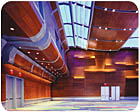
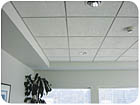
- Suspended ceilings
- Furred ceilings
- Direct contact ceilings
Each category has pros and cons and selection will depend on accessibility, space and economic budgets. The names of each category are somewhat self-explanatory. The terms are defined as they relate to the supporting structure.
The material selection will typically require more thoughtful consideration and no one ceiling is the answer to every set of needs. This article will focus on suspended ceilings. Suspended ceilings offer the most access, large plenums for HVAC ductwork and flexibility with future remodels.
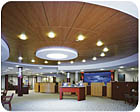
Lath and plaster
The oldest of the suspended ceilings are lath and plaster ceilings. They provide the ultimate in abuse resistance and life expectancy; they are some of the more expensive suspended ceilings, as plastering is not as common as other materials today. The can also be done in domes and a variety of configurations.The installation starts with hanger wires that are #8 gauge (0.1620) diameter galvanized, soft annealed steel wire and spaced 4 feet by 4 feet for gypsum plaster and 3 feet by 4 feet for cement plaster. The hanger wires support main runners that are 11⁄2 inch by 16 gauge cold rolled channels spaced 4 feet on center, they should be galvanized or coated for exterior or humid conditions. The main runners then support the furring channels wire tied and perpendicular to the main runners. Furring channels are 3/4 inch by 16 gauge cold rolled channels, the type of lath will determine the spacing of the furring. Generally the spacing is 16 inches on center for an expanded metal diamond lath weighing 3.4 pounds per square yard. Tie wire is 16 or 18 gauge galvanized, soft annealed wire.

Typical acoustical lay-in ceiling
Caveat: Contractors should be aware that with the advent of power tools, many trade people prefer to screw metal lath into hat channels rather than the traditional wire tying of cold rolled steel. The NWCB has seen a greater likelihood of cracking with this method of installation. It is recommended that a sheathing board be placed over the hat channel prior to screw attaching the lath.
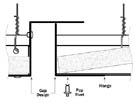
A seismic separation joint in an acoustical lay-in ceiling
Gypsum wallboard
These suspended ceilings are very popular today. They provide good abuse-resistance and produce a flat seamless look at a reasonable cost. Access to the plenum area can be achieved with installing access panels at various locations. These systems can be generic or proprietary. Generic systems resemble the lath and plaster suspension system with lighter gauge hanger wires and "hat" channels in lieu of furring channels.Hat channels have a flat face that allows for the gypsum panel to be screw applied to the suspension system. Proprietary systems typically have a snap lock or snap in system that allow for faster installation. When proprietary systems are used they should be followed carefully and not mix and match systems. At best mixing systems makes installation a challenge; at worst it can mean a failed system.
There are several types of gypsum or cement board panel products that can be attached to either of these suspension systems. Regular or Type X gypsum panels are the most common for interior applications and suitable for locations. They are easy to provide joint treatment and accept paint well. Areas subject to weather or high humidity would be better served with a proprietary board specifically designed for exposure. The NWCB typically recommends DensGlass Gold (G-P Gypsum), GlasRoc (BPB Gypsum) or Aqua Tough (USG) for exteriors or areas subject to continuous high humidity. The NWCB does not recommend the use of water-resistant gypsum panels (greenboard) for applications in areas subject to continuous moisture.
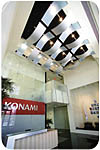
Acoustical lay-in ceilings
These ceilings provide the greatest accessibility to the plenum area and are easily retrofitted as the buildings need change for new tenants. As the name implies, the panels "lay in" to the suspension systems. Manufacturers have an unbelievable assortment of panels today. Building owners are not just limited to the boring plain white panels with tiny pin holes. Panels may be wood, glacier snow drifts or metal, some of these ceilings look like the waves of the ocean. The suspension systems also come in a wide variety of styles, shapes and sizes. If you have not checked out the options currently available, you are missing something. Two of the best Web sites to visit for an experience arewww.armstrong.com. Take the visual tour and enjoy.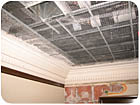
A traditional suspended lath and plaster ceiling
Code
The three model codes of the United States have merged to become one code for the entire nation. Each state is slowly adopting this new code and it is expected the United States will have a single code in the not-too-distant future. The International Building Code was first introduced in 2000 and then again in 2003. The IBC has some significant changes for lay-in acoustical ceilings in areas subject to seismic activity. The previous codes relied on seismic zones, namely 0-2 and 3-4. The IBC refers to Seismic Design Categories and the range from A-F. SDC is based on more than just location. Consider the soil type and building occupancy use to determine the SDC.The installation and design of a suspended lay-in ceiling can vary if the SDC is a D, E or F. This may also affect remodel work to existing buildings. The IBC is more reference based and has some unintended conflicting information.
The NWCB, industry representatives and building departments created a technical document to assist designers, contractors and building departments with the new requirements for installing the lay-in acoustical ceilings. The technical document is available free atwww.nwcb.org. The document was recently published in Arab Construction World as a standard for installing lay-in ceilings.
One item that can surprise a designer is the new requirement for seismic separation joints (see figure on page 17). These are now required to break larger acoustical ceilings into 2,500 square feet sections with a seismic separation joint.
The new code also requires large openings and escutcheon rings for fire sprinkler heads or a flexible head design.
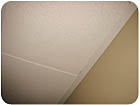
Two inch wall molding
Conclusion
In deciding what type of ceiling and finish materials best suit the building, owners, designers and contractors should be considering the following factors:- Acoustics
- Life expectancy
- Climate/chemical exposure
- Abuse resistance
- Maintenance requirements
- Fire rating requirements
- Seismic needs
- Plenum space for service items
- Access to plenum space
- Retrofit capabilities for future remodel and/or expansion
- Aesthetics
Careful consideration of each item with a designer will provide the best possible ceiling or limit the choices for that specific building or room.

